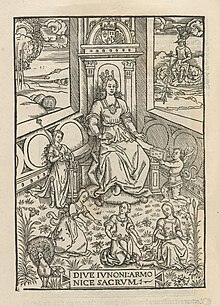Jean Lemaire de Belges
Jean Lemaire de Belges (* around 1473 in Bavay ; † after 1515 in Paris ) was a French author from what is now Belgium .
Life
Lemaire was born in Bavay and studied poetry in Valenciennes with his uncle Jean Molinet , who was the librarian of the Duke of Burgundy. After studying in Paris, he held offices with various princes, especially the regent of the Netherlands , Margarete von Habsburg , and the French Queen Anne de Bretagne . In 1506 and 1508 he traveled to Italy and there came into contact with the flourishing Italian Renaissance culture.
He began as a lyric poet in the style of the rhetoriqueurs and in 1504 introduced the Italian form of the terzine into French-language poetry. In 1505 he wrote the cheerful and melancholy Lettres de l'amant vert (Eng. Letters of the green lover), fictional letters from Margarete's real green parrot, who grieves to death because of a long absence of his wife and then of his experiences from the afterlife reported. In 1509 and 1511 Lemaire supported Annes Gatten, King Ludwig XII with literary propaganda . That is, he tried to justify its war of conquest in northern Italy and to gloss over his efforts to create a French church that was relatively independent of Rome (because the Pope was one of his war opponents), for example in the spirit of later Gallicanism .
plant
Lemaire's name is above all connected with the work Les illustrations de Gaule et singularités de Troye (1511–13; German about: The Glory Pages of Gaul and the Uniqueness of Troy ), which was widely read at the time . It is a retelling of the stories surrounding Troy (books I and II), followed by a genealogy of the founders of Gaul and the Frankish Empire up to Charlemagne (book III). Lemaire links Trojans and Franks via the figure of Francus , an alleged son of Hector ( not mentioned in Homer ) , who, together with Aeneas, the later founder of Rome , saved himself from Troy, conquered by the Greeks, in order to found ancient Gaul , whose continuation was in turn the early medieval Francia, the Frankish Empire.
The illustrations are based on many, in today's sense, pseudo-antique and pseudo-historical sources (e.g. a contemporary Latin Iliad adaptation). They are motivated by the author's dream of reuniting the old Franconian empire, i.e. France, Germany and the Netherlands (i.e. the current Benelux countries), even if it was initially only for the purpose of a common crusade against the Turks in 1453 the Christian Byzantium (now Istanbul ) had conquered.
Lemaire began the illustration in 1505 as Margarete's secretary in the Netherlands and completed it as the secretary and chronicler of Queen Anne of France. He himself thus formed a kind of bracket between the eastern and western parts of the old Franconian Empire (which under Charlemagne had stretched from Lübeck to Barcelona and from Brest to Rome around 800 ).
expenditure
- The Green Lover's Letters . Translated into German by Herrad Spilling based on the edition by Jean Frappier 1948. Fink, Munich 1970.
literature
- Paul Spaak : Jean Lemaire de Belges. Sa vie, son oeuvre et ses meilleures pages . Champion, Paris 1926 ( digitized ).
- Kathleen M. Munn: A contribution to the study of Jean Lemaire de Belges. A critical study of bio-bibliographical data, including a transcript of various unpublished works . Slatkine, Genève 1975 (reprint of New York 1936 edition)
- Pierre Jodogne: Jean Lemaire de Belges, écrivain franco-bourguignon . Académie Royale de Belgique, Bruxelles 1972
Web link
- Literature by and about Jean Lemaire de Belges in the catalog of the German National Library
- Gert Pinkernell: Articles in the names, titles and dates of French literature (source)
| personal data | |
|---|---|
| SURNAME | Lemaire de Belges, Jean |
| BRIEF DESCRIPTION | French-speaking author from what is now Belgium |
| DATE OF BIRTH | around 1473 |
| PLACE OF BIRTH | Bavay |
| DATE OF DEATH | after 1515 |
| Place of death | Paris |
